Let’s face it: When most of us are looking for style inspiration these days, the first place we go to is the Internet. And whether we’re looking through images online or even back in the day when we were browsing through magazines, what we’ll be seeing is really a representation of current fashions more than of timeless style.
Models & The Modern Tailoring
Case and point, let’s take a look at modern tailoring. Most of the models you’re going to see in menswear publications these days are exceptionally skinny 20-somethings who really look more like teenagers. It’s safe to say that this is a body type and physique that 90% of Gentleman’s Gazette readers aren’t going to have. Even someone like me who is on the taller side and definitely slim, isn’t quite athletic enough to fit this ideal modern body type.
Mod Fashions
So then, the modern style is all about the slim and narrow but, where did this come from? In our video on History of the Suit in 22 Minutes, we talked about the Mod fashions of the 1950s and 60s and indeed, these looks are still influencing modern style today. The typical Mod suit was slim fitting with narrow lapels and was often worn with similarly narrow ties. It featured slim flat-fronted trousers that had narrow leg openings. As an example of this style, you can take a look at some of the suits worn by members of the Rat Pack in movies that they made in the late 50s and early 60s.
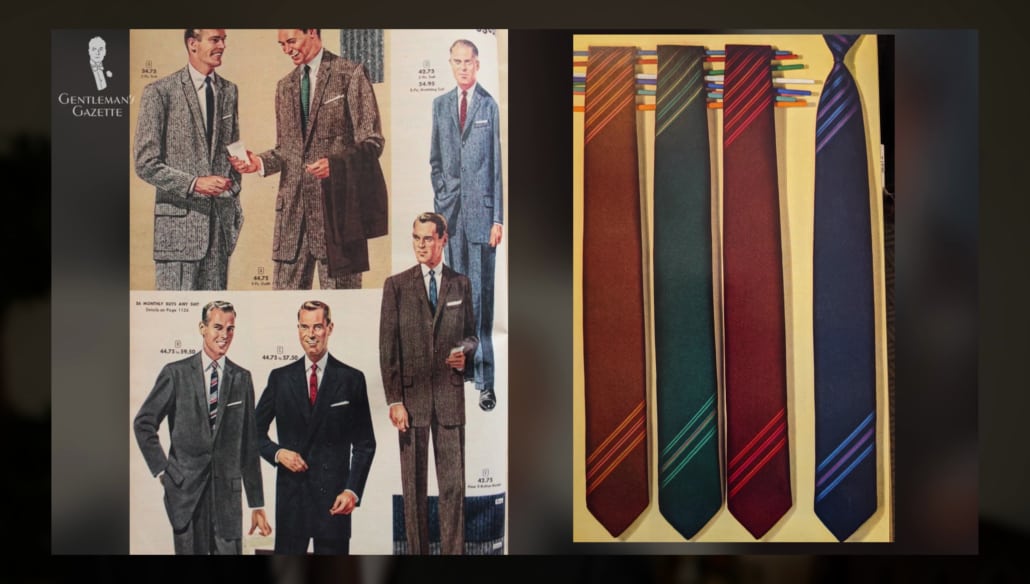
Men’s fashion during the 1950s – 1960s
As the 60s progressed, these mod suits got even slimmer and the pants also got shorter and more tapered meaning that you wouldn’t see a break over the shoe. Overall, the history of men’s fashion can be characterized by actions and reactions. So, you’ll see things like lapels getting wider or narrower overtime and cuts being more baggy or more slim.
The mod style then was a reaction against the more full cuts of earlier generations which were coming to be seen as old fashioned. But by the 1980s and 90s, everything was suddenly looser and more full cut again as a reaction to the slimmer styles that were now 20 years or so old.
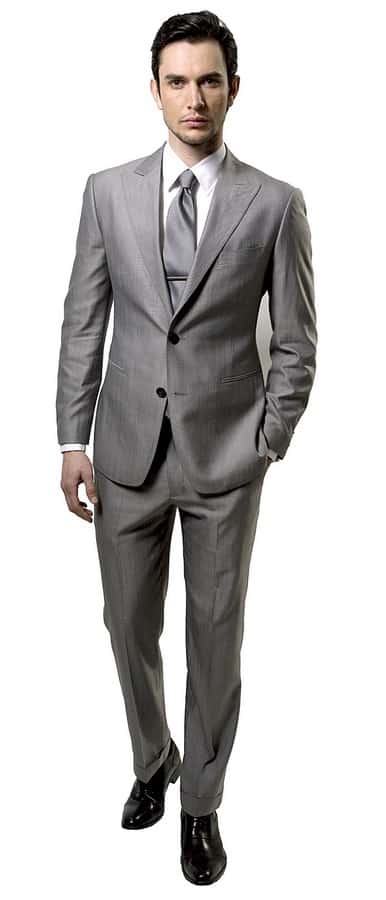
Modern Lightweight Suit with Wrinkles
Then, in the 2000s, things flipped once again and we’ve been in the slim fit camp up to the present day. For examples of this, you can look at the current retail giant Suit Supply and for an extreme example, the work of American fashion designer Tom Brown. So it’s established that modern suits are very slim cut and therefore don’t work ideally for many men. But even if you’re not wearing a full suit — just a dress shirt and trousers, you might still experience some of these same fit problems.
Modern Shirts
Traditionally, men’s dress shirts were much more full-fitting allowing for a greater range of motion if you wanted to do something like raise your arms. Because shirts were considered an undergarment in previous decades and thus wouldn’t be seen unless underneath a jacket or other outer layer, this fuller fit wouldn’t be seen as sloppy.
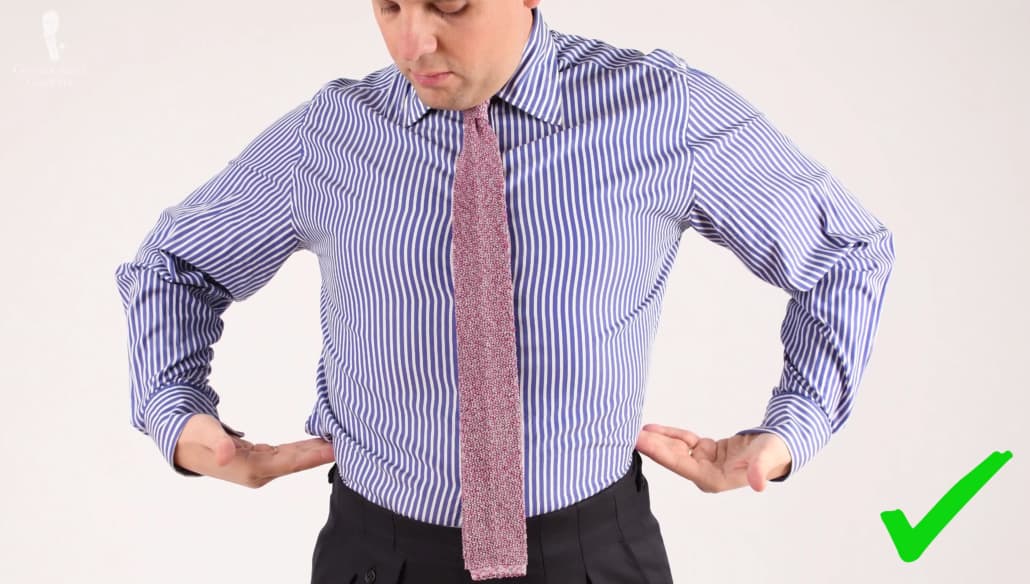
In the modern style, however, slim fit is definitely king and you’ll even see some retailers marketing shirts with things like extra slim fit or super slim fit. This will likely cause problems if you have wider shoulders or any kind of a belly, however. Unless your whole torso is uniformly thin, you’re probably going to experience some pulling of the shirt fabric across your chest.
This will detract from a clean and uniform look when you’re standing up and will be especially apparent if you’re wearing a shirt with a pattern like stripes. Rather than being straight up and down, the stripes are going to be crooked and broken. Because of this, many modern shirts will have spandex or elastane added into the weave to allow a bit more stretch of the fabric. However, this will likely mean that the longevity of the shirt is lower over time and you might find fewer options from any one retailer. While you’ll experience some minor issues while standing, these will likely be further compounded when you’re sitting.

The placket, which is where the shirts buttons are, could even gap in addition to folding and creasing. This will make the front of the shirt look like an accordion and even worse it could expose your undershirt or bare skin through these gaps. Imagine being in a business meeting or on a first date and having your navel exposed through one of these shirt gaps. Definitely not a professional or good look.
You could try to cover up some of this gapping and creasing with a necktie, of course, or you could just wear a shirt with a bit more room so that the gapping wouldn’t happen in the first place.
Modern Trousers
As we said before, the Mod style of the 50s and 60s was characterized by thin tapered and flat-fronted trousers with narrow leg openings. Many of today’s trouser offerings are similar and again they’re not going to be flattering to all body types.
For example, if you’ve got larger thighs either from working out cycling or just due to genetics, modern slim fit pants might not work for you. For one thing, they’re going to look unsightly, wrinkling and bunching and will make your legs look a bit like sausage casings and they might also be uncomfortable. What’s more, the seams could even tear if subjected to enough pressure.
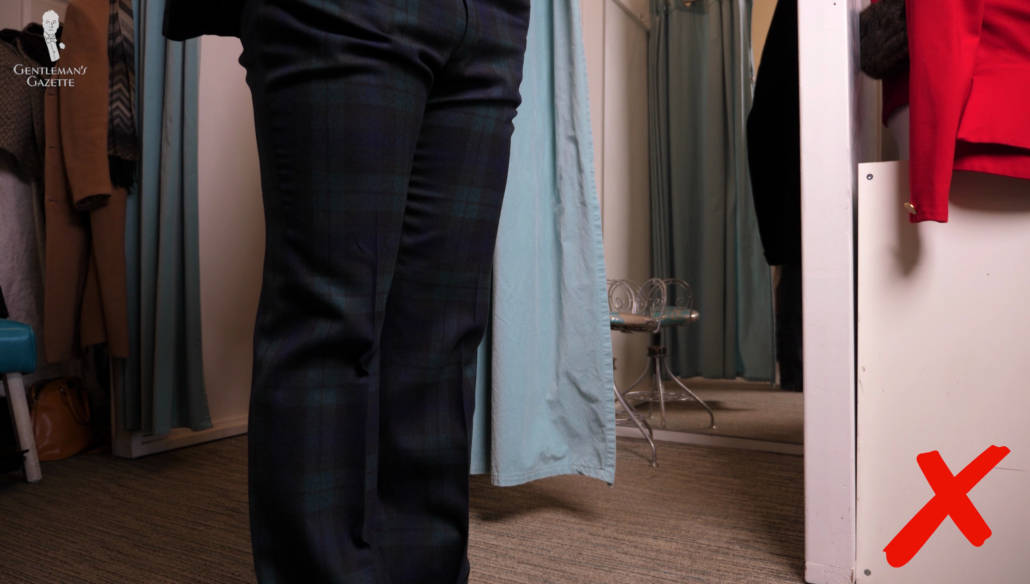
Modern slim fit pants will not work for those men with larger thighs
Similarly, if you’re carrying any excess weight in your midsection, flat-fronted pants might not be your best option. You could verticalize your look a little bit more and, therefore, slim yourself down visually by trying pleated pants. Pleats have a bad reputation today because of the baggy pleated styles of the 1980s and 90s, but these are extreme outlier examples. Today’s pleated styles are more moderate overall and of course, remember that pleated pants are a staple of men’s fashion going as far back as the Golden Age of the 1930s and 40s and seen on Hollywood icons like Clark Gable and Cary Grant.
In addition to emphasizing your vertical line, pleats will also give you a bit more room in the trouser and thus, more comfort especially when sitting. However, while you can certainly find pleated pants today, they’re not going to be standard in most modern styles.
Your typical modern cut also tends to have a lower rise. This is the distance from the crotch of the trouser to the top of the waistband. Essentially, the rise measures how far up your waist the pants will sit. A low rise is associated again with that slim teenage build but it’s definitely not going to work for everyone. Especially again, if you’ve got weight in your midsection, this low rise will probably cause a bit of a muffin top and will make your tucked-in shirts look especially unsightly.
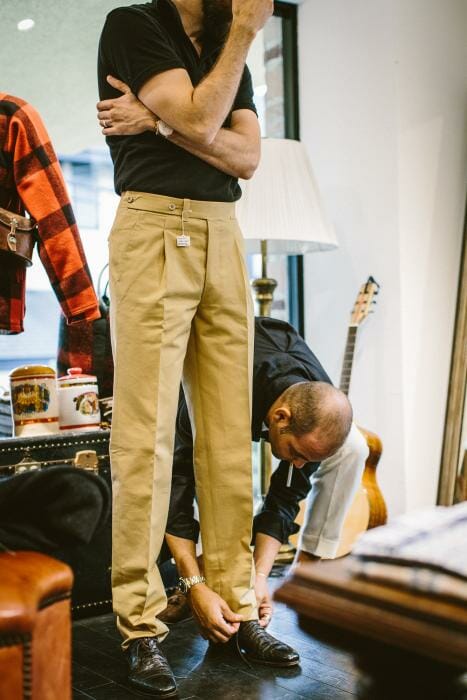
Simon Crompton of Permanent Style wearing Ambrosi pleated pants with a moderate cut
As is the case with pleats. A higher rise that sits closer to your natural waist, essentially in line with your navel, can make you more comfortable and give you a more flattering look. Classic style dictates that you not show any exposed shirt between the bottom of your necktie and your waistband when you’re standing and your jacket is buttoned.
As a bonus here, wearing trousers with a higher rise will ensure that this dreaded triangle of shirt fabric won’t be seen. Additionally, one thing that’s often overlooked in today’s styles, is the relatively narrow leg opening of many pairs of pants. If you have a fairly large shoe size, a narrow leg opening is going to look off proportionally and might even make your feet look clownish. A larger leg opening of roughly 7 ½ to 8 ½ inches will look more proportional with large shoe sizes.
Modern Jackets
In jackets marketed as fashionable today, you’re often going to find a fit that is exceptionally close to the body, very narrow lapels, a higher buttoning point and a shorter length overall. While these design features can look good on some, they’re definitely not for everyone.
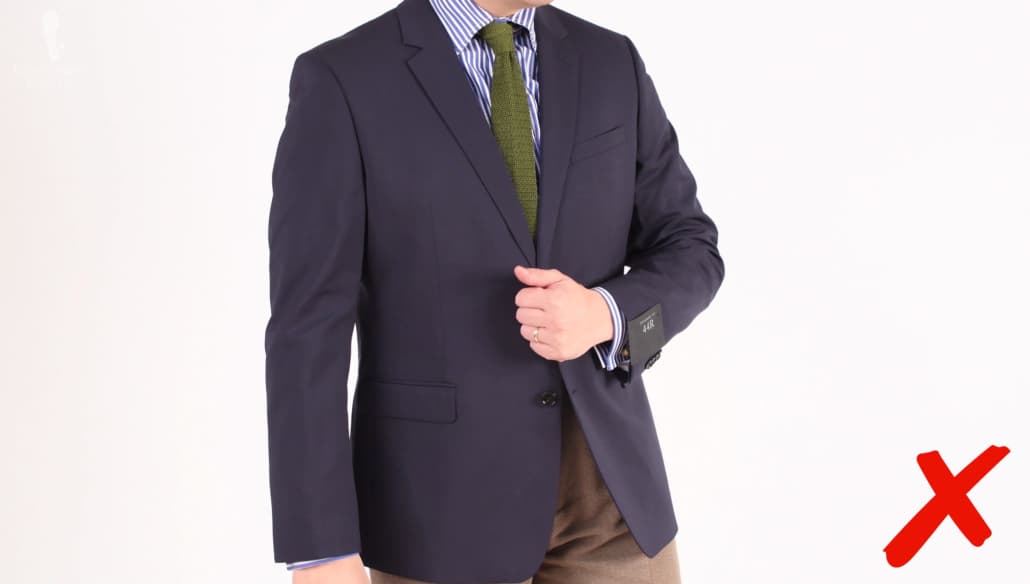
Narrow lapels, often accompanied by a similarly skinny tie, are ideally meant for tall and thin men. The narrowness will make the wearer’s chest seem broader because there’s more space between the lapel and the shoulder. This is why narrow lapels look fine on the boyish models who are often wearing them but if you’ve got a naturally broader chest already, narrow lapels will probably look out of proportion. In general then, narrower lapels are going to look better for a narrower chest and broader lapels for a broader chest.
Modern jackets are also known for being shorter in length overall than more traditional styles. A traditional jacket is supposed to cover your seat or rear end when you’re standing. However, modern jackets are often going to be cut shorter leaving more of the seat exposed. Overall, the bottom of a jacket is where your body is divided in two and thus, these modern jacket styles will often leave your torso looking shorter and your legs longer.
This, in and of itself, wouldn’t necessarily be a bad thing as higher rise trousers are also designed to lengthen the leg line. However, because modern trousers as we’ve already discussed, typically have a lower rise, that paired with a shorter jacket style can often leave things looking a bit awkward overall around your midsection.
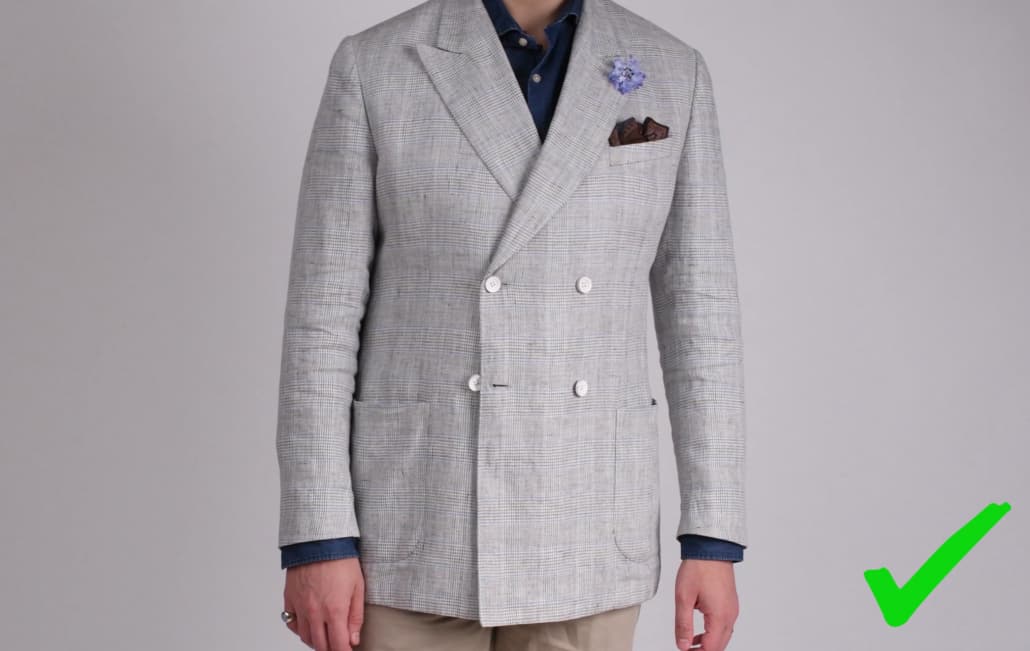
Raphael wearing a glen check double-breasted jacket combined with a Brown with Blue Paisley pocket square and Blue Cornflower Boutonniere from Fort Belvedere
If you do have a body type that’s characterized by shorter legs and a longer torso, a slightly shorter jacket might work for you. But, still trying to follow the baseline of having the jacket cover your seat is going to look good on most men.
Finally here, the buttoning point on a jacket is where the waist button is positioned. This is the top button that you’re supposed to button when standing. It might not always be the top button on the jacket itself, but it’s the one that is supposed to be buttoned.
These days, the buttoning point on many jackets has been migrating higher and higher on the chest making the upper torso look shorter and wider. This is why it’s often modeled by tall, thin men because it will help their shoulders to look a bit broader. This high buttoning point, in other words, is working to balance out the lean build of these models. However again, if you do already have a naturally broader chest or larger build having a jacket with a lower buttoning point closer to the natural waist will probably work better for you.

If you have a broad chest or a shorter torso, a buttoning point at your natural waist, which is also where your belly button is, would work better.
Conclusion
Be careful when you’re buying men’s wear in modern and or trendy styles. Remember that the purpose of a garment is to flatter and accentuate your natural proportions and give you a more ideal visual silhouette overall. Therefore, if you’re really going to be able to pull off modern and trendy styles well, you’ll probably need the body type that suits these kinds of garments best. You’ll need to be tall, thin, and ideally youthful.
Even if you are in the small percentage of the general population for whom these styles would work, however, you might not want to wear them. Why is this? Well after all, they are still trends at the end of the day and trends will eventually go out of style. What we would suggest, both for men who do fit this ideal modern body type and for the many men who don’t, is to lean on a more classic style; the one that we discuss here most often at the Gentleman’s Gazette. If you can incorporate these timeless style hallmarks into your looks, you won’t be immediately dated by the kinds of garments you’re wearing and we’ll have a more timeless overall look.
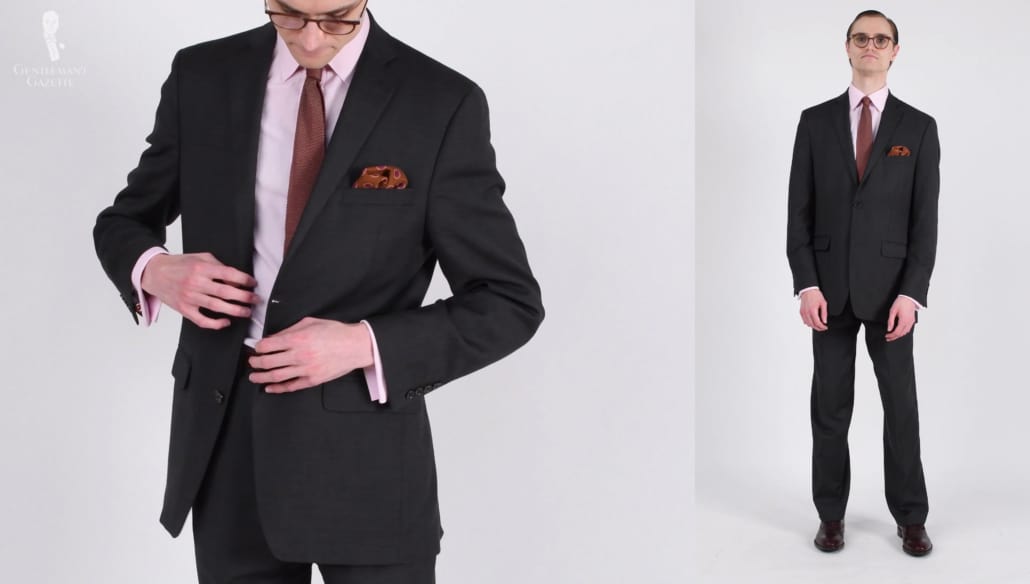
Preston wearing an ensemble that is a bit more modern in style but still has classic influences combined with Fort Belvedere accessories.
So, while modern styles may have their ideal target customers, a classic style is likely going to be more timeless and more comfortable for the vast majority of men. In these cases, then, your choice should be clear.
from Gentleman's Gazette https://ift.tt/2D4Tsx7

0 Comments